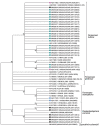Endemic Chromoblastomycosis Caused Predominantly by Fonsecaea nubica, Madagascar1
- PMID: 32441639
- PMCID: PMC7258462
- DOI: 10.3201/eid2606.191498
Endemic Chromoblastomycosis Caused Predominantly by Fonsecaea nubica, Madagascar1
Abstract
Chromoblastomycosis is an implantation fungal infection. Twenty years ago, Madagascar was recognized as the leading focus of this disease. We recruited patients in Madagascar who had chronic subcutaneous lesions suggestive of dermatomycosis during March 2013-June 2017. Chromoblastomycosis was diagnosed in 50 (33.8%) of 148 patients. The highest prevalence was in northeastern (1.47 cases/100,000 persons) and southern (0.8 cases/100,000 persons) Madagascar. Patients with chromoblastomycosis were older (47.9 years) than those without (37.5 years) (p = 0.0005). Chromoblastomycosis was 3 times more likely to consist of leg lesions (p = 0.003). Molecular analysis identified Fonsecaea nubica in 23 cases and Cladophialophora carrionii in 7 cases. Of 27 patients who underwent follow-up testing, none were completely cured. We highlight the persistence of a high level of chromoblastomycosis endemicity, which was even greater at some locations than 20 years ago. We used molecular tools to identify the Fonsecaea sp. strains isolated from patients as F. nubica.
Keywords: Fonseca pedrosoi; Fonsecaea nubica; Madagascar; chromoblastomycosis; clinical outcome; clinical presentation; dermatomycosis; epidemiology; fungal infections; fungi; molecular diagnosis; prevalence.
Figures



References
Publication types
MeSH terms
Substances
Supplementary concepts
LinkOut - more resources
Full Text Sources

